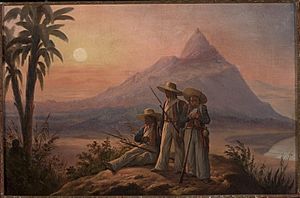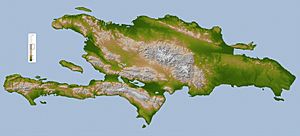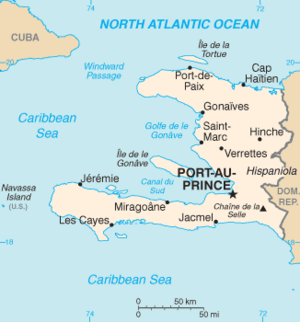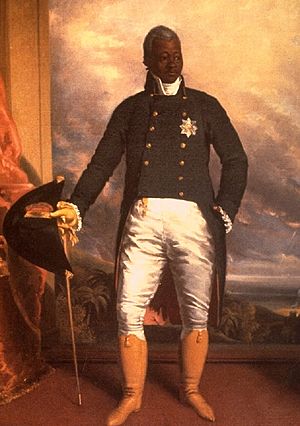Saint-Domingue expedition facts for kids
Quick facts for kids Saint-Domingue expedition |
|||||||
|---|---|---|---|---|---|---|---|
| Part of the Haitian Revolution | |||||||
 Legioniści na San Domingo by January Suchodolski |
|||||||
|
|||||||
| Belligerents | |||||||
|
|||||||
| Commanders and leaders | |||||||
Rochambeau Federico Gravina |
|||||||
| Casualties and losses | |||||||
| 35,000-40,000 | 80,000 | ||||||
The Saint-Domingue expedition was a major military invasion by France. It was sent by Napoleon Bonaparte, who was then the leader of France. His goal was to take back control of the Caribbean colony of Saint-Domingue, which is now Haiti.
The expedition aimed to stop the independence and freedom that former slave Toussaint Louverture had brought to the island. It started in December 1801. After some early wins, the French were defeated at the Battle of Vertières. French troops left the island in December 1803. This defeat ended Napoleon's hopes of having a French empire in the West.
Contents
Why the Expedition Happened
The French Revolution caused big changes in Saint-Domingue. The most important change was a slave revolt. This led to the end of slavery in 1793. Toussaint Louverture, a former slave, became a powerful leader. France recognized him as Governor. He brought peace, fought off Spanish and British attacks, and helped the island become successful again.
However, Toussaint went too far for France. He took control of the Spanish part of the island in 1801. He also created his own constitution, which said he would be governor for life. This challenged France's power.
At this time, France had made peace with many European countries. Napoleon could now focus on problems within France and its empire. He decided to send a large army to Saint-Domingue. He put his brother-in-law, General Charles Leclerc, in charge.
Napoleon first planned to let Toussaint's officers keep their ranks and land. He also thought about making Toussaint his deputy. He even sent Toussaint's sons, who were studying in France, back home. But by October 1801, Napoleon changed his mind. He saw Toussaint's constitution as an insult to French authority. Napoleon secretly told Leclerc to disarm Toussaint's government. He also ordered Leclerc to send Toussaint's military officers to France.
Napoleon expected Toussaint to fight back. Toussaint had over 16,000 soldiers. So, Leclerc was given command of 30,000 men. These soldiers came from many parts of the French Revolutionary Army.
The French Invasion Begins
On December 14, 1801, a large French fleet left France. It had 21 frigates and 35 ships of the line. Admiral Villaret de Joyeuse led this fleet. It carried 7,000–8,000 soldiers. More ships with troops followed in the next months. These included Polish soldiers and help from Spanish Cuba. In total, over 31,000 troops landed on Saint-Domingue. Some non-white figures, like André Rigaud and Alexandre Pétion, also joined the French. Toussaint had forced them out of the colony earlier.
The French ships met in the Samaná Bay. The admirals divided their fleets to surprise Toussaint. General Kergerseau went to Santo Domingo. General Jean Boudet went to Port-au-Prince. Leclerc and Villaret de Joyeuse sailed to Cap-Haïtien.
When Toussaint saw the French ships, he gave orders. He told his generals, Henri Christophe, Jean-Jacques Dessalines, and Laplume, to talk with the French. If the French landed, they were to burn the towns. They were also to kill the white people and then retreat into the mountains.
French Take Control
Villaret arrived at Cap-Haïtien on February 3. The attack began on February 5. Christophe followed Toussaint's orders. He set the town on fire and killed some white residents. On February 6, Rochambeau landed and captured Fort-Dauphin.
Leclerc set up his main base at Cap-Haïtien. He sent ships to North America for supplies. Meanwhile, Latouche-Tréville and Boudet took Port-au-Prince and Léogâne. Laplume surrendered to them. General Kergerseau landed at Santo Domingo with 2,000 men. He took control of much of the Spanish part of the island.
In the first ten days, the French took over the island's ports, towns, and much of the farmland. Toussaint and his remaining soldiers hid in the mountains. The French would have to fight through narrow, thick jungles. These areas were perfect for ambushes.
More French ships arrived with fresh troops. Leclerc also had a secret weapon: Toussaint's sons. They carried a letter from Napoleon. It promised Toussaint a high position if he surrendered.
On February 17, Leclerc launched a big attack. His divisions moved from different directions. The goal was to surround Toussaint's forces at Gonaïves. Despite the tough land and resistance, the plan worked.
On February 23, French troops entered Gonaïves, which was on fire. General Boudet took Saint-Marc, also burning. Maurepas and his 2,000 troops fought hard but finally surrendered. The French also captured Fort de la Crête-à-Pierrot. They found many weapons and dead white residents there. At Verrettes, the French found a terrible scene. Rebels had killed 800 people, including women and children. They also killed any prisoners.
Toussaint's forces ran out of supplies. The area they controlled became smaller. Their soldiers lost hope. Christophe offered to surrender. Dessalines and Toussaint followed. Toussaint was placed under house arrest. Leclerc gave him back his rank and properties. By late April and early May, order seemed to return to the island. Trade restarted, and the former rebels kept their lands and ranks.
French Defeat and Haitian Independence
While under house arrest, Toussaint saw the French army getting weaker. Many French soldiers were dying from yellow fever. About 15,000 died in just two months. Toussaint secretly encouraged his leaders to be ready for another fight. Leclerc sensed danger. In June, he arrested Toussaint and sent him to France. Toussaint was held in a prison called Fort de Joux.
News spread that slavery was being brought back in other French colonies. This made the people of Saint-Domingue very angry. Leclerc decided to disarm the black soldiers. This only made them angrier. Yellow fever also hit the French hard. Leclerc himself died of yellow fever on November 1, 1802. His wife, Pauline Bonaparte, was very sad.
Rochambeau took over as the new commander. He tried to stop the new revolt, but it was too late. By August 1802, many black and mixed-race soldiers left the French army. In October, former rebel leaders Alexander Petion, Henri Christophe, and Jean-Jacques Dessalines also left the French side. The French forces were now very small, with only 8,000 to 10,000 men.
Rochambeau became very cruel. He ordered the arrest of all remaining black colonial troops. Many were killed. This included loyal officers like Maurepas, who was drowned with his family.
The rebels pushed the French back to Cap-Haïtien. On November 18, 1803, the French were defeated at the Battle of Vertières by General Jean-Jacques Dessalines. By the end of December, the last French soldiers left the island. On their way back to France, Rochambeau was captured by the British.
What Happened Next
The expedition was a huge loss for France. More than 20 French generals died. Only about 7,000 to 8,000 of the 31,000 soldiers sent to Saint-Domingue survived.
On January 1, 1804, Dessalines declared Saint-Domingue an independent country. He named it Haiti. It was the second independent state in the Americas. Dessalines became governor general for life. Later, he was crowned Emperor Jacques I. He ordered the killing of the remaining French colonists in Haiti. He also created a system where people had to work on farms, which was similar to forced labor.
Dessalines was killed on October 17, 1806. The country then split into two parts. A kingdom in the north was led by Christophe as Henri I. A republic in the south was led by Alexandre Pétion. In 1826, France demanded a huge payment from Haiti for recognizing its independence. This debt was finally paid off by the mid-20th century.
See also
- Reconquista (Santo Domingo), 1808–1809
- C.L.R. James, The Black Jacobins : Toussaint L'Ouverture and the San Domingo Revolution, 1st ed. 1938, 2nd ed. 1963






